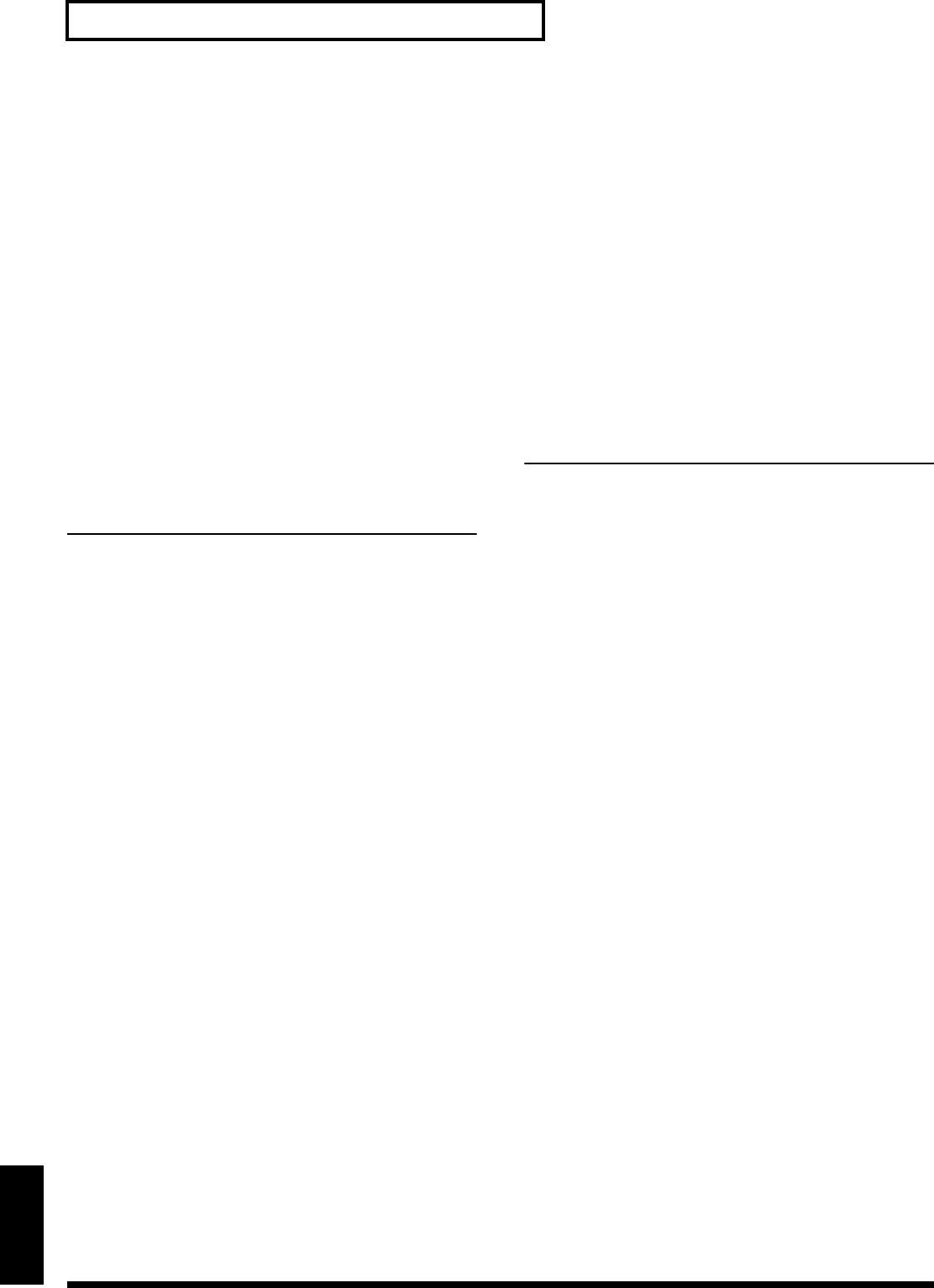
118
Effect/Parameter List
Appendices
HF Damp
Adjust the frequency at which the high frequency range of the
delayed sound returned to the input will be cut.
If you do not want to cut the high frequencies of the feedback,
set this parameter to BYPASS.
Low Gain
Adjust the low frequency gain (amount of boost or cut). Positive
(+) settings will emphasize (boost) the low frequency range.
High Gain
Adjust the high frequency gain (amount of boost or cut).
Positive (+) settings will emphasize (boost) the high frequency
range.
Balance (Effect Balance) #
Sets the volume balance between the direct sound and the effect
sound. With a setting of D100:0W only the direct sound will be
output, and with a setting of D0:100W only the effect sound will
be output.
Level (Output Level)
Adjust the output level.
46: REVERSE DELAY
Reverse Delay is a delay effect that adds the reverse of the input
sound as the delay sound.
Delay 1 (Delay Time 1)
Adjust the delay time from the direct sound until the delay 1
sound is heard.
Delay 2 (Delay Time 2)
Adjust the delay time from the direct sound until the delay 2
sound is heard.
Delay 3 (Delay Time 3)
Adjust the delay time from the direct sound until the delay 3
sound is heard.
Delay 4 (Delay Time 4)
Adjust the delay time from the direct sound until the delay 4
sound is heard.
➔
Delay 1–4 parameters can be set as a note-value of a tempo. In
this case, specify the value of the desired note.
Feedback 1:4 #
Adjust the proportion (%) of the delay 1 and 4 sound that is fed
back into the effect. Positive (+) settings will return the signal to
the input with the original phase, while negative (-) settings
produce an inverted phase.
HF Damp 1:4
Adjust the frequency above which delayed sound (Delay 1, 4)
fed back to the delay input will be cut.
If you do not want to cut the high frequencies of the feedback,
set this parameter to BYPASS.
Threshold (Threshold Level)
Specify the volume level at which the reverse delay will begin
to apply.
Pan 1:2:3 (Output Pan 1:2:3)
Adjust the pan of delay sound (Delay 1–3). A setting of L64 is
far left, 0 is center, and 63R is far right.
Level 1:2:3
Adjust the output level of delay 1, 2 and 3.
Low Gain
Adjust the low frequency gain (amount of boost or cut).
Positive (+) settings will emphasize (boost) the low frequency
range.
High Gain
Adjust the high frequency gain (amount of boost or cut).
Positive (+) settings will emphasize (boost) the high frequency
range.
Balance (Effect Balance) #
Sets the volume balance between the direct sound and the effect
sound. With a setting of D100:0W only the direct sound will be
output, and with a setting of D0:100W only the effect sound will
be output.
Level (Output Level)
Adjust the output level.
47: SHUFFLE DELAY
Shuffle Delay adds a shuffle to the delay sound, giving the
sound a bouncy delay effect with a swing feel.
Delay (Delay Time) #
Adjust the delay time from the direct sound until the delay
sound is heard.
➔
Delay parameter can be set as a note-value of a tempo. In this
case, specify the value of the desired note.
Shuffle (Shuffle Rate) #
Sets the ratio (as a percentage) of the time that elapses before
the sound plays in Delay B relative to the time that elapses
before the sound plays in Delay A. When set to 50%, the delay
times are the same.
Accel (Acceleration)
Adjust the time over which the Delay Time will change from the
current setting to a newly specified setting. The rate of change
for the Delay Time directly affects the rate of pitch change.
Feedback #
Adjust the proportion (%) of the delay sound that is to be
returned to the input. Positive (+) settings will return the signal
to the input with the original phase, while negative (-) settings
produce an inverted phase.
HF Damp
Adjust the frequency above which delayed sound fed back to
the delay input will be cut.
If you do not want to cut the high frequencies of the feedback,
set this parameter to BYPASS.
Pan A
Adjust the pan of the delay A sound.
Pan B
Adjust the pan of the delay B sound.
Level Bal (Level Balance)
Sets the balance for the levels of the delay A and the delay B.
Low Gain
Adjust the low frequency gain (amount of boost or cut).
Positive (+) settings will emphasize (boost) the low frequency
range.
RD-700_e.book 118 ページ 2004年4月26日 月曜日 午前11時54分


















